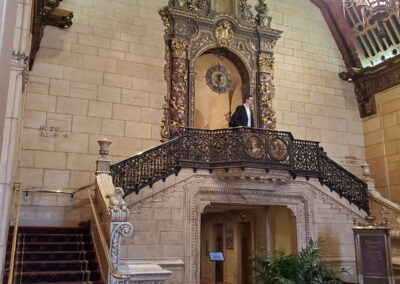The annual California Preservation Foundation (CPF) Conference was recently held in downtown Los Angeles, hosted at the fabulous Millenium Biltmore Hotel, which celebrated its 100th Anniversary last year. The conference theme this year was Building Shelter, Community, and Sustainability. Many of the sessions focused on housing, and one of the more interesting presentations was called Why Bad Office Buildings Make Good Housing Buildings. The presenters, including Michael Strong from Pankow Builders and Principal Marc Steyer from Tipping Structural, explained that much of our Class B and C downtown core historic office buildings have ideal floorplates for double-loaded housing layouts and are desirable targets for adaptive reuse or rehabilitation projects. As the market for office space continually shrinks in the wake of the pandemic and discovery of work from home benefits, we are challenged to rethink how we can take advantage of the available building stock, reinvigorate, and repopulate downtowns. Skills from the field of historic preservation can be used to bolster these efforts.
Since recently joining Interactive Resources, Inc., a small but mighty architectural firm located along the Bay in the historic and charming neighborhood Point Richmond, I was delighted to discover that we have sponsored this event for over a decade. Our President and founder, Tom Butt, who joined me at the event, has been a fierce defender of historic buildings for all his professional life as an architect and most recently as the two-term Mayor of Richmond. Thanks to Tom’s efforts, many of Richmond’s most iconic historic buildings have been saved from demolition and rehabilitated. Tom is the principal author of most of the historic preservation legislation in the City of Richmond. It is from that foundation that Interactive Resources, Inc. has built an enduring legacy of local, regional, and national historic preservation work.
What impressed me this year about the conference attendees compared to past events was the broad spectrum of professionals and advocates dedicated to preserving our buildings, culture, stories, and history. This is likely more about my developing perspective and not a change in the field. Another encouraging discovery was the sense of community and willingness of fellow professionals to share their strategies for saving old buildings, detailed case studies, and success stories.
After the classroom-based sessions concluded, I was able to explore and tour some popular sites such as the recently renovated Griffith Park Observatory and carefully restored Victorians on Carroll Avenue in Angelino Heights, one of the city’s oldest neighborhoods. Since northern and southern California take turns every year hosting the Conference, attendees have an opportunity to explore different urban environments and historic districts. Hope to see you in Sacramento at next year’s conference!
Author: Chris Lutjen, AIA, LEED AP BD+C







